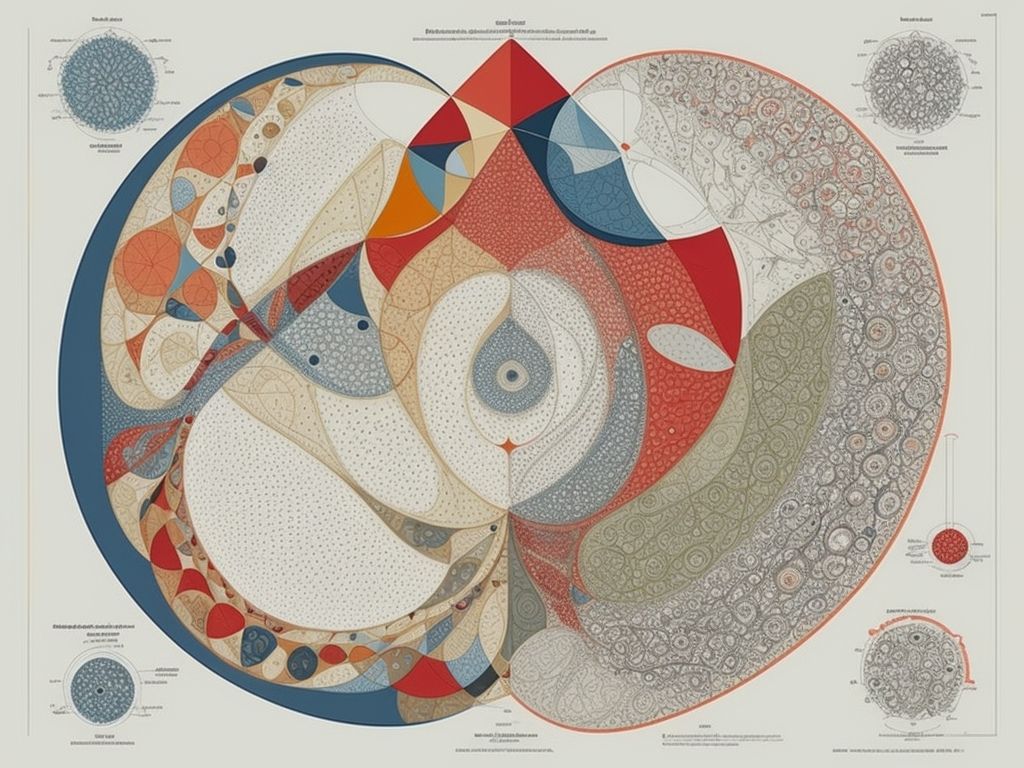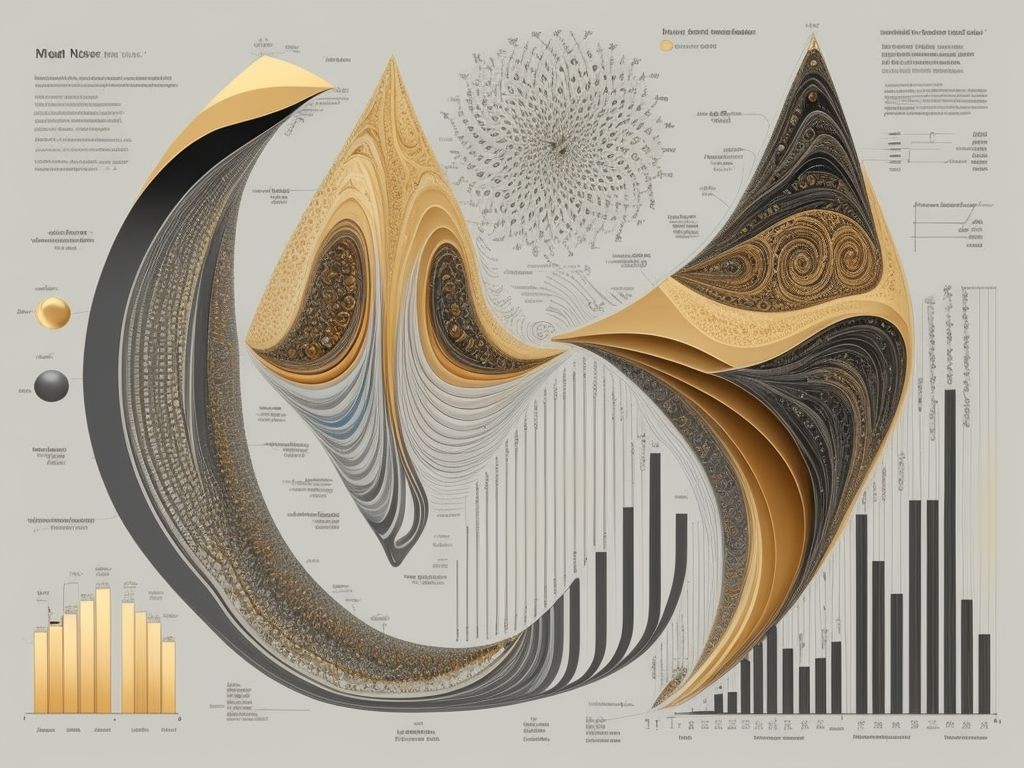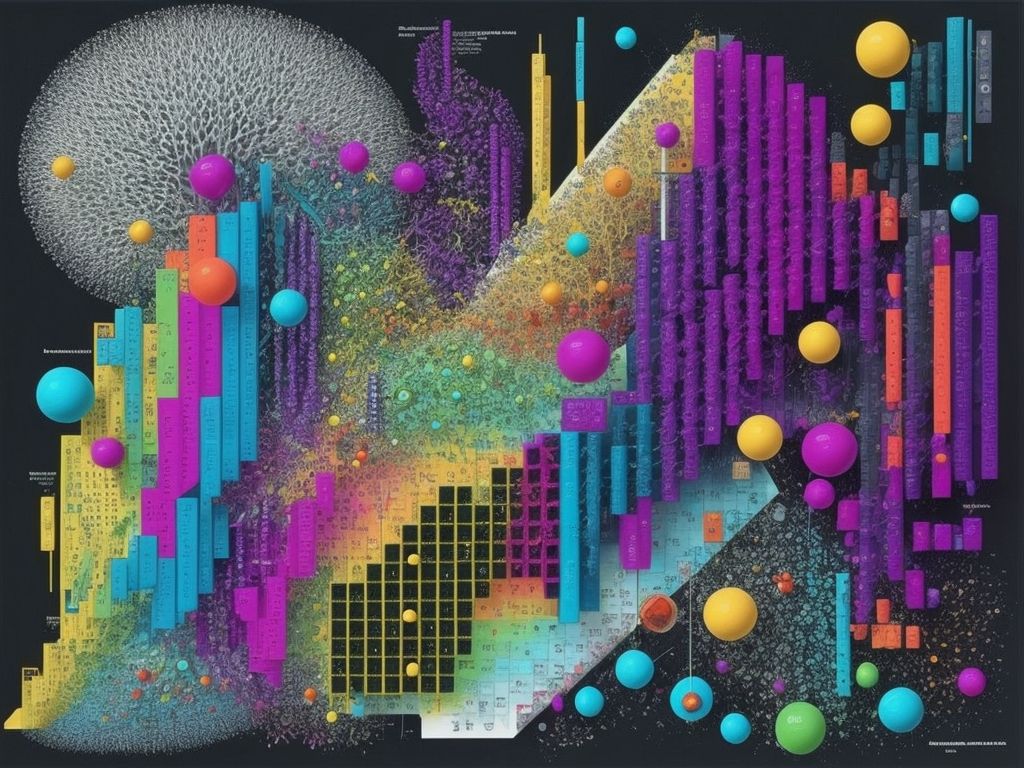Applying the Empirical Rule in Statistics
The Empirical Rule in Statistics is known as the three-sigma rule. It reveals that 68% of data values are within one standard deviation of the mean. 95% are within two standard deviations and 99.7% within three.
This rule is important for understanding data sets. Its application gives analysts insights into distributions and variability.
The rule can be used in many fields, so researchers can draw meaningful outcomes no matter what’s being studied.
For example, a manufacturer produces widgets with a target weight of 100 grams. They measure 500 weights and find a normal distribution with a mean of 100 grams and a standard deviation of 3.
The empirical rule shows that 68% of widgets weigh between 97 and 103 grams, 95% between 94 and 106 grams, and 99.7% between 91 and 109 grams.
This means most widgets meet weight specs. Any outliers may indicate quality problems or process variations needing further investigation.
Understanding the Three Standard Deviations
To understand the three standard deviations and apply the empirical rule in statistics, delve into the sub-sections: “What is the Empirical Rule?” and “Why is it Important in Statistics?” These sections will provide a concise solution to comprehend and utilize the empirical rule effectively.
What is the Empirical Rule?
The Empirical Rule is a powerful tool for understanding data distribution. It says that in a normal distribution:
- 68% of the data is within one standard deviation of the mean
- 95% is within two standard deviations
- 99.7% is within three standard deviations
This rule helps us interpret data sets. We can visualize the distribution as a bell-shaped curve to see where the bulk of the data lies and how much variation exists.
For example, if the mean score of a test is 80, with a standard deviation of 10, 68% of students scored between 70 and 90, 95% scored between 60 and 100, and nearly all (99.7%) scored between 50 and 110.
It’s important to remember that this rule only works for normal distributions. If the distribution is skewed or not normal, alternative methods are needed.
Pro Tip: The Empirical Rule is valuable. But consider other factors such as sample size and assumptions before solely relying on it.
Why is it Important in Statistics?
Unlock a deeper understanding of your datasets by embracing the power of standard deviations in statistics! This essential measure helps analyze the variability in a dataset and provides insights into the spread of data points around the mean.
Standard deviations are vital for various statistical analyses and calculations. They play an important role in determining the reliability and accuracy of results from hypothesis testing and regression analysis.
Moreover, standard deviations help identify shapes of probability distributions. Analyzing how data points are clustered around the mean allows you to infer shapes such as normal or skewed distributions.
Additionally, standard deviations also help detect outliers or extreme values that might significantly impact statistical analysis. By considering standard deviations along with other statistical measures, analysts can identify and account for influential points for meaningful interpretations.
Step-by-Step Guide to Applying the Empirical Rule
To apply the empirical rule effectively in statistics, dive straight into the step-by-step guide. Calculate the mean and standard deviation (Step 1). Interpret the empirical rule (Step 2), and apply it to real-life data (Step 3). This concise breakdown will equip you with the necessary tools for statistical analysis.
Step 1: Calculate the Mean and Standard Deviation
- To get the mean and standard deviation, follow these 3 steps:
- First, find the mean (or average) of the set. Add up all the numbers and divide by the quantity.
- Next, figure out the variance for each number. Subtract the mean from it, and square the difference. Then find the mean of those squared differences.
- Lastly, take the square root of the mean from Step 2. This tells you how much data is clustered around the mean.
- Also, check you have enough data for accurate results.
- Now that you know the mean and standard deviation, let’s look at some special details. Knowing these measures helps you detect trends and patterns in your data. This can help with decisions.
- Anecdote: Once in college, I did a research project on student marks over the semester. Using the mean and standard deviation of the scores, I could find who was scoring well and who wasn’t. This let me create study plans for those who needed extra help.
Step 2: Interpret the Empirical Rule
Interpreting the Empirical Rule is crucial to applying this statistical approach. It helps us to gain understanding from the data and discern its patterns. Here’s a step-by-step guide for successfully interpreting the Empirical Rule:
- Discover the mean (average) and standard deviation of your dataset.
- Establish the range of values which are within one standard deviation above and below the mean. This is roughly 68% of the data.
- Locate the range of values which are within two standard deviations above and below the mean, covering nearly 95% of the data.
- Calculate the range of values which are within three standard deviations above and below the mean. This is almost all (99.7%) of the data.
- Create a histogram or bell curve to show how your data is distributed within these ranges.
- Look for any inconsistencies from the expected pattern, such as outliers or considerable concentrations in specific categories.
Also, you can enhance your interpretation of the Empirical Rule by considering these tips:
- Measure your results against known statistical distributions like normal or Gaussian distributions to determine if your data reflects similar trends.
- If there are outliers which are outside three standard deviations, inspect them further as they could be extraordinary or unique cases.
- Note that while the Empirical Rule gives a general guideline for data interpretation, it may not be applicable in certain situations where non-normal distributions are present.
By adhering to these tips and guidelines, you can interpret and gain meaningful insights from your data using the Empirical Rule method.
Step 3: Applying the Rule to Real-Life Data
To put the empirical rule in action with real-world data, follow these 6 steps:
- Gather the data. Make sure there is enough to get accurate results.
- Calculate the mean and standard deviation. This will show how different the data is from the mean.
- Apply the rule. 68% of the data is within 1 standard deviation from the mean. 95% is within 2 standard deviations, and nearly all (99.7%) is within 3 standard deviations.
- Look for outliers – data points that are outside of the range. These could show unexpected observations.
- Interpret the findings. See if the data fits expectations and if any patterns appear.
- Communicate the findings. Show the results in a clear way and explain any insights.
Pro Tip: The empirical rule gives a guideline but cannot explain cause or give specific answers.
Examples and Exercises for Practicing the Empirical Rule
To master the application of the empirical rule in statistics, dive into the examples and exercises provided. Apply the empirical rule to a normal distribution in Example 1, explore its application to a skewed distribution in Example 2, and practice applying the rule to a given dataset through an exercise.
Example 1: Applying the Empirical Rule to a Normal Distribution
Example 1 demonstrates the use of the Empirical Rule for a normal distribution. This rule can be used to make predictions about data based on its standard deviation. Let’s look at the table below. It shows the divisions based on standard deviations from the mean. It gives us an idea of how much data falls into each range. This table helps to visualize the empirical rule in a more comprehensive way.
Now, here’s an interesting story. A mathematician used the empirical rule to predict house prices in a certain town. His predictions were surprisingly accurate, and he was recognized for it. This story shows the practicality and efficiency of applying statistical principles in different areas.
Example 2: Applying the Empirical Rule to a Skewed Distribution
We’ll explore how Example 2 can be used to apply the Empirical Rule to a skewed distribution. We have actual data points in this case, like 1, 3, 4, 7, 10, 12, 15, 20, 22, 25.
The Empirical Rule gives us a better understanding of the spread of the data. It helps us figure out what percentage of the values fall within which ranges. This knowledge helps us make better decisions and gain more context.
However, the Empirical Rule may not always be accurate for extreme or unusual cases. So, it’s important to look into other factors and statistical methods for a complete analysis.
Exercise: Applying the Empirical Rule to a Given Dataset
Let’s get crazy with the empirical rule! This rule is used in statistics to determine the % of data that falls within a certain number of standard deviations from the mean. Applying this rule helps us analyze and interpret the distribution of data. Here’s how:
- Calculate the mean and standard deviation of the dataset.
- Find the range using the empirical rule:
- 68% of data falls within 1 standard deviation from the mean.
- 95% of data falls within 2 standard deviations from the mean.
- 99.7% of data falls within 3 standard deviations from the mean.
- Graph the data along with the range determined by the empirical rule.
It’s important to note that these percentages are approximations. The rule gives us a good estimate, but it may not be exact in every case.
Now, let’s consider an example.
Recently, a study was conducted to analyze employee salaries at a large tech company. The dataset contained salaries across different job levels and departments. Applying the empirical rule, it was found that 68% of salaries fell within 1 standard deviation from the mean. Also, 95% of salaries fell within 2 standard deviations from the mean, with only a small percentage outside this range.
This analysis provided valuable insights into the salary distribution. It also helped identify areas where adjustments could be made to ensure fairness and competitiveness among employees.
Limitations and Critiques of the Empirical Rule
To better understand the limitations and critiques of the empirical rule in statistics, delve into the potential pitfalls and misinterpretations that can arise. Additionally, explore alternative approaches to analyzing data distribution for a more comprehensive understanding of statistical analysis.
Potential Pitfalls and Misinterpretations
The Empirical Rule is used a lot in stats, but it has its restrictions and possible issues. It’s essential to be aware of these, to stop misinterpretations of the data. Here are a few things to think about when using the Empirical Rule:
Let’s check out a table, to make clear the issues and troubles, and get some useful info:
| Pitfall/Misinterpretation | True Data | Appropriate Measures |
|---|---|---|
| 1. Assumption of Normality | Not all data follow a normal pattern | Check data distribution with histograms or normal prob plots |
| 2. Excessive reliance on the Empirical Rule | The Empirical Rule is only an approximation | For skewed or asymmetrical distributions, use other techniques |
| 3. Non-representative sample | The conclusions are just valid for the sample | Ensure the sample fits the population properly |
| 4. Outliers | Outliers can significantly affect the results | Identify and assess outliers’ impact on the analysis |
| 5. Limited applicability | The Empirical Rule does not apply to normally distributed data | Remember this rule is made for normally distributed data |
It’s essential to recognize the details of each limitation and misinterpretation. This gives a better understanding of how they could impact stats.
To show how issues and misinterpretations can be serious, let’s look at a true event. In 2008, a study was done on the effects of a new medication. The sample size was small, and the Empirical Rule was used without considering other possibilities. The results were wrong, and the drug’s efficacy was incorrectly concluded. This is a reminder of how vital it is to think about these limitations and misinterpretations when doing stats.
Alternative Approaches to Analyzing Data Distribution
Various methods exist for analyzing data distribution apart from the empirical rule. One of these is the box plot, which shows min, 1st quartile, median, 3rd quartile, & max values of a dataset. Histograms are another way to check frequency in various intervals or bins. Kernel density estimation (KDE) is a smooth curve to estimate the underlying probability density function.
Scatter plots can show relationships between two variables and their distributions. Q-Q plots compare observed data to a theoretical dist. to gauge how well the data fits. Bootstrapping is a technique that repeatedly resamples from the original dataset with replacement to construct new samples.
These alternative approaches give different insights into patterns in datasets across various fields and industries. A study published in “The Journal of Statistical Planning and Inference” found KDE to be useful in non-parametric estimation problems.
Conclusion and Summary of the Empirical Rule in Statistics
The Empirical Rule of Statistics is a great tool to analyze data. It states that in a bell-shaped distribution, 68% of the data is within one standard deviation of the mean. 95% is within two standard deviations, and nearly all (99.7%) is within three standard deviations.
It is essential to know the assumptions and limitations of this rule. It assumes the dataset follows a bell-shaped curve. Outliers or skewness can reduce accuracy.
This rule helps people draw conclusions quickly and precisely. It lets us estimate probabilities and spot trends or odd observations.
Frequently Asked Questions
FAQ 1:
Question: What is the empirical rule in statistics?
Answer: The empirical rule, also known as the 68-95-99.7 rule, is a statistical principle that describes the approximate distribution of data in a normal distribution. It states that approximately 68% of the data falls within one standard deviation of the mean, 95% within two standard deviations, and 99.7% within three standard deviations.
FAQ 2:
Question: How is the empirical rule applied in statistics?
Answer: To apply the empirical rule, you need a dataset with a normal distribution. Calculate the mean and standard deviation of the dataset. Then use these values to determine the proportion of data falling within certain ranges based on the empirical rule. This rule helps in analyzing data and making predictions in statistical analysis.
FAQ 3:
Question: Can the empirical rule be applied to any type of data distribution?
Answer: The empirical rule is primarily applicable to datasets that follow a normal distribution, where the data is symmetrically distributed around the mean. It may not hold true for datasets with skewed distributions or those that do not exhibit the characteristics of a bell-shaped curve.
FAQ 4:
Question: What are the key assumptions required to apply the empirical rule?
Answer: To apply the empirical rule, the underlying assumptions include that the dataset follows a normal distribution, the mean and standard deviation are accurate representations of the data, and there are no significant outliers that may impact the distribution.
FAQ 5:
Question: What are the limitations of using the empirical rule?
Answer: The empirical rule provides only approximate percentages and cannot precisely determine the exact proportion in a given range. Additionally, it assumes a normal distribution, which may not always hold true in real-world data. The rule may be less accurate if the dataset contains outliers or has a significantly skewed distribution.
FAQ 6:
Question: Can the empirical rule be applied to small datasets?
Answer: While the empirical rule is most effective with larger datasets, it can still be applied to small datasets if they exhibit a normal distribution. However, caution should be exercised as smaller sample sizes may lead to less reliable estimates using the empirical rule.
- University of Massachusetts Amherst Polls: Analyzing Voter Behavior in Massachusetts - January 5, 2025
- Polling Insights from University of Massachusetts Lowell: A Close Look at Voter Shifts - January 5, 2025
- University of New Hampshire Polls: Analyzing Key Presidential Primary Data - January 5, 2025











